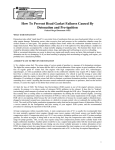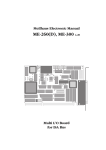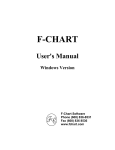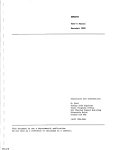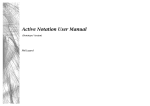Download ME 300 COURSE POLICY AND SCHEDULE
Transcript
ME 300 COURSE POLICY AND SCHEDULE FALL 2014 1. INSTRUCTORS Division 1: 10:30 to 11:20 a.m. MWF in ME-2061 Sameer V. Naik Email: [email protected] Office Hours: 11:30 a.m. to 12:30 p.m. MWF in ME-G092 Phone: 496-2183 Division 2: 1:30 to 2:20 p.m. MWF in ME-2061 Jay P. Gore Email: [email protected] Office Hours: 2:30 to 3:30 p.m. MWF in ME-3166 Phone: 494-0061 Teaching Assistant Ruoyu You Email: [email protected] Office Hours: T 1:30 to 5:30 p.m. and Th 3:30 to 5:30 p.m. in ME-2142 (Tutorial Room 3) 2. OBJECTIVES: The objectives of this course are as follows: (a) To provide a thorough understanding of the application of classical thermodynamics to practical problems. Topics include transient energy analysis, exergy (availability) analysis, ideal gas mixtures (non-reacting and reacting), and chemical equilibrium analysis. Applications include internal combustion engines, gas turbine engines (power generation and aircraft), vapor power and refrigeration/heat pump systems, and air conditioning systems. (b) To provide an introductory treatment of thermodynamics for an expanded range of materials including ideal gas mixtures, real fluids, and reacting systems. (c) To provide limited design experience for systems requiring significant considerations of thermodynamics. 3. TEXTBOOK: Moran, M.J., Shapiro, H.N., Boettner, D. D., and Bailey, M. B., th Fundamentals of Engineering Thermodynamics, 7 ed., John Wiley & Sons, NY (2011). 4. PREREQUISITE: ME 200 or equivalent. 5. COMPUTER SOFTWARE: A non-linear equation solver with built-in thermodynamic properties and graphics capabilities will be used to analyze selected problems in this course. This computer program, called Engineering Equation Solver (EES), is available on the PCs in the ME Computer Laboratories. Students may make copies of this program for personal use. Instructions for copying and executing EES are attached at the end of this document. Help with EES is available through the on-line help command within the EES software and also through a complete EES User’s Manual available at https://engineering.purdue.edu/me300/ and http://www.fchart.com/. Note: You do not need to purchase the optional software that comes with the textbook. We will not use the software provided with the textbook in ME 300. 1 ME 300 COURSE POLICY AND SCHEDULE FALL 2014 You will need an ME ECN account in order to access EES on the PCs in the ME Computer Laboratories. If you do not already have an ME ECN account, see a consultant in ME2042 during the first week of classes to establish an account. Please check the ME 300 website (https://engineering.purdue.edu/me300/) to access homework problems and solutions, exam solutions, and other announcements during the semester. 6. ASSIGNMENTS: Reading assignments are provided in the course schedule. As basic preparation for each lecture, students should read the assigned section of the textbook or lecture handouts before coming to class. Representative problems have been assigned for each lecture. These problems are illustrative of the general material and of problems found on exams. Keeping up on these problems is an excellent way to prepare for exams and in-class quizzes. Only special problems (SP) will be collected and graded. Homework will be collected according to the attached schedule. No late homework will be accepted unless you have instructor’s permission in advance. Solutions to the assigned problems will be posted on the course website. Posting of solutions is provided only as a convenience to check answers, not to replace student effort. Students must use 8 ½ by 11 inch engineering paper when solving problems. Only one side of the paper should be used and no more than one problem should be included per page. When handing in your assignment, staple all pages in order. If EES software is used in solving a problem, printout of well-commented EES code must be attached to the problem solution. The following problem solution format should be used. Note that it is similar, but a little different, than the one described in your textbook (Section 1.9, page 24): A. At the top of the engineering paper there are 5 boxes. Starting from the left: i. Box 1 - leave blank ii. Box 2 - put your name (last, first, middle) iii. Box 3 - put the problem number, e.g. Special Problem 1 iv. Box 4 - leave blank v. Box 5 - put the page number of the problem/total pages for this problem, i.e. 1/3 or 3/3 B. Below the boxes place: i. Given: State in your own words what is given in the problem statement, e.g. Initial temperature T1 = 30°C ii. Find: List the parameters and values that you are asked to determine, e.g. Pressure at state 2 or P2 iii. System Sketch: A drawing that includes either control volume or control mass iv. Assumptions: e.g. Ideal gas v. Basic Equations vi. Solution: The problem should be worked analytically before numbers are plugged into formulas and calculations are performed. After the numerical solution is obtained, units should be checked and initial assumptions should be re-evaluated. Graders will be instructed to give equal weight in grading to the format of the solution (organization, clarity of writing, problem sketch, etc.) and to the correct analysis and answer. Special attention will be paid to units. It is anticipated that quizzes will be given in class. The day of the quiz will not be announced in advance. The problems in the quiz may be similar to the assigned homework problems. 2 ME 300 COURSE POLICY AND SCHEDULE FALL 2014 7. EXAMINATIONS: There will be two (2) one-hour evening examinations. Evening examination dates, times, and locations are indicated in the course schedule. A two-hour comprehensive final examination will be given during finals week. There will be no make-up exams except in cases of illness, official conflict, or serious emergency. Students with excusable absences due to the aforementioned reasons will be assigned a grade for the missed exam equal to the average of the two remaining exams. All examinations will be closed book and closed notes. You will be provided with an equation sheet. You will be allowed to bring in pen(s)/pencil(s), a calculator that works (with extra batteries), an eraser, and a straight edge. Cell phone, computers, and all other electronics must be turned off and placed in a backpack during the entire examination. The backpack must be placed on the floor for the entire examination. Failure to do so will be considered cheating and you will receive a score of zero on the examination. ME Exam Calculator Policy Only calculator that is permitted to be used during all exams is the TI-30X IIS, a two-line, basic scientific calculator. This calculator was specifically selected for four reasons: (1) its simplicity of use, (2) its basic functionality (no added bells or whistles), (3) its low cost ($13), and (4) its wide availability (available at most retail stores, e.g., Wal-Mart, or online, Amazon.com, etc.). As such, there is no significant imposition on students to purchase this low-cost exam calculator. Students retain the freedom to use their calculator of choice on homework, labs, projects, and quizzes; however, students are encouraged to practice using their exam calculator to make sure they fully understand its functionality. The reason for this policy is to address growing inequity and academic dishonesty issues due to different calculators used by students during exams. With the advent of wireless calculators and highly-sophisticated graphing calculators, a specific calculator policy was needed to ensure the integrity of the exam process and to provide all students with equal opportunity to succeed on exams. With only one exam calculator option, this also enables instructors to more easily verify that all students are utilizing the authorized calculator during an examination. Use of unauthorized calculators during any exam will be consider violation of academic honesty. Students who violate this policy are subject to sanctions from the instructor, up to and including a failing grade on the exam or even a failing grade in the course. Furthermore, all infractions will also be reported to the Office of the Dean of Students as potential violations of the Purdue University Code of Student Conduct which may result in additional sanctions being assigned, including probation, suspension, or even expulsion from the University. Any questions about this policy should be addressed to your instructor. EXAMINATION GRADING: On examinations, points will be deducted if you do not follow the problem solution format as outlined in Item 6B. In other words, points will be deducted if you do not show what the system looks like and list what your basic equation(s) is (are). In addition, you will lose points if you do not clearly indicate your assumptions and if you do not provide sufficient detail during your analysis so that the instructor can understand what you have done and why you have done it. Finally, you must carry units through during your analysis, and must avoid sign errors in all energy quantities, plus correctly identify the direction of relevant work and heat transfer terms. Please note that partial credit will be given only if you work your way completely through the problem. For example, writing basic equations and 3 ME 300 COURSE POLICY AND SCHEDULE FALL 2014 assumptions without going through the steps to the final answer may not receive any partial credit. 8. HELP: The course instructors will hold office hours during the week. Students may receive help from any of the instructors. Office hours and room numbers are listed in this document and posted on the course web site. Teaching assistants will hold office hours in the tutorial room as listed in this document and as posted on the course website https://engineering.purdue.edu/me300/. 9. GRADING: The course grade will be determined from the more favorable of the following two distributions: One-hour Exams (2) ........................................... either 45% or 30% Final Examination .............................................. either 30% or 45% In-class Quizzes ............................................... 15% Homework ........................................................ 10% Total ................................................................... 100% Based on participation criteria (attendance, diligence, etc.), the instructors also reserve the option of raising or lowering any border-line grade. Please note that in-class quizzes will be given without any prior announcement. 10. CAMPUS EMERGENCIES: In the event of a major campus emergency, course requirements, deadlines, and grading percentages are subject to changes that may be necessitated by a revised semester calendar or other circumstances. Such changes will be posted on the website: https://engineering.purdue.edu/ME300. You may also be informed of such changes by email from the instructor. 11. ACADEMIC DISHONESTY: Any form of dishonesty on an examination (or quizzes or homework assignments), as defined by Section III.B.2 of the University Regulations, results in a grade of zero for that case of dishonesty (in case of homework assignments, the semester homework grade of 10% will be zero) and a letter will be sent to the Dean of Students recommending that you be placed on probation. After more than one instance you will receive a failing grade for ME 300 and a letter will be sent to the Dean of Students recommending that you be expelled from Purdue University. 12. CLASSROOM RULES: Common courtesy while in the classroom is a pre-requisite for learning. The following is expected of students in ME 300: Turn off cell phones before entering the class room. It distracts and annoys those sitting near you when your phone goes off during lecture. Do not read the newspaper once lecture has started. Those behind you cannot see the board/overhead screen through the paper. It is also insulting to your instructor. Remove the newspapers, soda cans, candy wrappers, and anything else you bring into the room when you leave. There are trashcans for any refuse. 4 ME 300 COURSE POLICY AND SCHEDULE FALL 2014 13. SOME ADVICE: It is implied that you will ask questions, participate in class discussions, be prepared to answer questions when called upon, and generally be alert in class. Frequent absences or lack of participation directly impact your performance. Reading your textbook and reviewing your class notes, and working the homework problems on a daily basis is the best way to ensure you learn the material and are prepared for examinations. Hard work and perhaps some struggle is generally required, especially in the early stages of the class; so try and get into the swing of things as soon as possible. Good luck! 5 ME 300 COURSE POLICY AND SCHEDULE FALL 2014 Executing and Copying EES within the ME Building EES (Engineering Equation Solver) is available for use on and to copy from the personal computers located in the ME building. Instructions for executing and copying the program are given below. 1. Using EES within the ME building: EES operates within the Windows environment on PCs that are located within the ME building. To execute the program, do the following: a) b) c) Log onto to a PC. Locate the EES icon in the folder labeled “Applications” Double click on the EES application to launch the program. This sequence should put you within the EES program. There are a number of examples in an “Examples” subdirectory (use OPEN under the FILE menu within EES to load an example from C:\EES32\USERLIB\EXAMPLES) that can help you in getting started. ME-ECN account is necessary to access the PCs in the ME building. Print from within EES by selecting the Print option under the FILE menu. 2. Copying EES for Personal Use: Purdue has a site license for EES that allows you to copy the program and use it on any computer for your school work. However, this agreement only pertains to use of EES while you are a Purdue student. This program version should not be used for commercial purposes. After graduation, you may wish to purchase a commercial version if you are interested in using EES for programming purposes. A Windows version of the program can be copied from the PCs in the ME building to an external media device. The program is stored in the directory C:\EES32. You can copy the EES32 folder and place it in a new directory called C:\EES32 on your computer. You may also wish to create a shortcut to it on your desktop. Alternatively, you can go to https://engineering.purdue.edu/MECL/MELS and download EES. 6 Lect Day Date Subject Reading 1 M Aug 25 Review - Properties, Work, Heat Transfer 2 W Aug 27 3 4 5 6 F M W F M Aug 29 Transient Energy Analysis Sep 1 Labor Day - No Class Sep 3 Transient Energy Analysis (contd.) Sep 5 Review - Second Law Sep 8 Review - Second Law (contd.) 7 8 9 10 11 12 13 14 15 16 W F M W F M W F M W Sep 10 Sep 12 Sep 15 Sep 17 Sep 19 Sep 22 Sep 24 Sep 26 Sep 29 Oct 1 Exergy Exergy Analysis - Closed System Exergy Analysis - Open System Exergy Analysis - 2nd Law Efficiency Ideal Gas Mixtures Mixing and Separation Processes Psychrometric Principles and Temperatures Psychrometric Charts and Applications Psychrometric Charts and Applications (contd.) Psychrometric Charts and Applications (contd.) 7.1-7.3 7.4 7.5 7.6 12.1-12.3 12.4 12.5, 12.6 12.7, 12.8 12.8, 12.9 12.8, 12.9 17 F Oct 3 Stoichiometry of Reactions 13.1 18 19 M W Th Oct 6 Oct 8 Oct 9 13.2 F M W F M Oct 10 Oct 13 Oct 15 Oct 17 Oct 20 Energy Balance for Reacting Systems Review Exam 1, Lectures 1-16, 6:30 to7:30 p.m., in WTHR 200 No class due to Exam 1 Fall Break - No Class Energy Balance for Reacting Systems (contd.) Adiabatic Flame Temperature Entropy Balance for Reacting Systems 4.116, 4.120, SP-4 5.20, 5.34, 5.54, SP-5 6.20, 6.41, 6.58, 6.88, 6.112, SP-6 7.5, 7.18, SP-7 7.27, 7.31, SP-8 7.51, 7.64, SP-9 7.94, 7.101, SP-10 12.5, 12.16, SP-11 12.36, 12.41, SP-12 12.48, 12.60, SP-13 12.66, 12.68, SP-14 12.70, 12.76, SP-15 12.81, 12.97, 12.103, SP-16 13.4, 13.17, 13.42, SP-17 13.45, 13.49, SP-18 13.2 13.3 13.5 13.58, 13.64, SP-20 13.70, SP-21 13.81, SP-22 20 21 22 Review - First Law 1.2-1.6, 2.1-2.4, 3.1-3.12 2.5, 2.6, 4.1-4.11 Problems 4.12 4.12 5.1-5.11, 6.1, 6.2 6.3-6.13 7 3.10, 3.28, 3.39, 3.54, 3.97, SP-1 2.31, 2.58, 2.66, 4.38, 4.88, 4.95, SP-2 4.110, 4.111, SP-3 Lect Day Date Subject Chemical Equilibrium Criteria Equilibrium Compositions Equilibrium Compositions (contd.) Equilibrium Flame Temperature van't Hoff Equation, Ionization Simultaneous Reactions Pollutant Formation and Reduction Vapor Power Cycle Rankine Cycle Superheat, Reheat, and Regeneration, Exergy Analysis Vapor Compression Cycle Advanced Refrigeration Systems Review Exam 2, Lectures 1-29, 6:30 to 7:30 p.m., in WTHR 200 Internal Combustion Engine Cycle Gas Turbine Plants and Brayton Cycle No class due to Exam 2 Thanksgiving Break - No Class Thanksgiving Break - No Class Brayton Cycle Regeneration, Intercooling, and Reheat Aircraft Gas Turbines Aircraft Gas Turbines (contd.) Course Review Course Review Course Review 23 24 25 26 27 28 29 30 31 W F M W F M W F M Oct 22 Oct 24 Oct 27 Oct 29 Oct 31 Nov 3 Nov 5 Nov 7 Nov 10 32 33 34 W F M T Nov 12 Nov 14 Nov 17 Nov 18 35 36 W F M W F M W F M W F Nov 19 Nov 21 Nov 24 Nov 26 Nov 28 Dec 1 Dec 3 Dec 5 Dec 8 Dec 10 Dec 12 37 38 39 40 41 42 Reading 14.1, 14.2 14.3 14.3 14.4.1 14.4.2, 14.4.3 14.4.4 Problems 8.1, 8.2 8.3, 8.4, 8.6 14.3, 14.9, SP-23 14.11, SP-24 14.32, 14.35, SP-25 14.40, 14.55, SP-26 14.60, 14.63, SP-27 14.70, SP-28 14.14, SP-29 8.14, SP-30 8.31, 8.92, SP-31 10.1-10.3, 10.6 10.4, 10.5, 10.7 10.17, 10.41, SP-32 10.48, SP-33 9. 9.5, 9.6 9.13, 9.28, SP-35 9.52, SP-36 9.7, 9.8 9.11 9.11 9.83, SP-37 9.86, SP-38 9.92, SP-39 Comprehensive Final Examination, Lectures 1- 42, December 15-20, date, time, and location to be announced 8 ME 300 Thermodynamics II Homework Schedule HW Assignment HW#1 SP-1, SP-2, SP-3 HW#2 SP-4, SP-5, SP-6 HW#3 SP-7, SP-8, SP-9 HW#4 SP-10, SP-11, SP-12 HW#5 SP-13, SP-14, SP-15 HW#6 SP-16, SP-17, SP-18, No SP-19 HW#7 SP-20, SP-21, SP-22 HW#8 SP-23, SP-24, SP-25 HW#9 SP-26, SP-27, SP-28 HW#10 SP-29, SP-30, SP-31 HW#11 SP-32, SP-33, SP-35 No SP-34 HW#12 SP-36, SP-37 HW#13 SP-38, SP-39 Posted Due Monday, 08/25 Wednesday, 09/03 Wednesday, 09/03 Wednesday, 09/10 Wednesday, 09/10 Wednesday, 09/17 Wednesday, 09/17 Wednesday, 09/24 Wednesday, 09/24 Wednesday, 10/01 Wednesday, 10/01 Wednesday, 10/15 Wednesday, 10/15 Wednesday, 10/22 Wednesday, 10/22 Wednesday, 10/29 Wednesday, 10/29 Wednesday, 11/05 Wednesday, 11/05 Wednesday, 11/12 Wednesday, 11/12 Wednesday, 11/19 Wednesday, 12/03 Wednesday, 12/03 Wednesday, 12/10 9 Friday, 11/21









